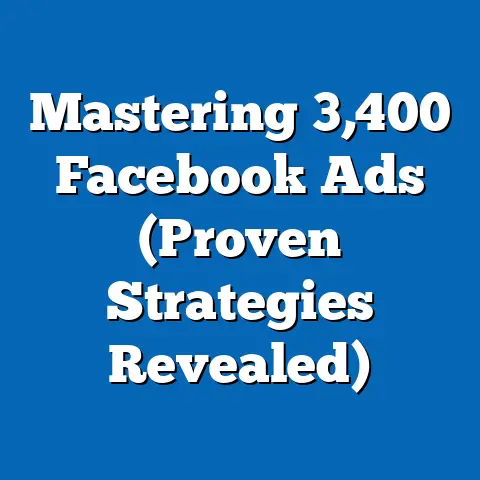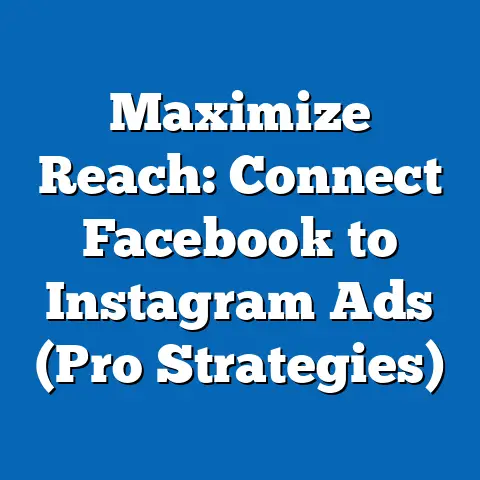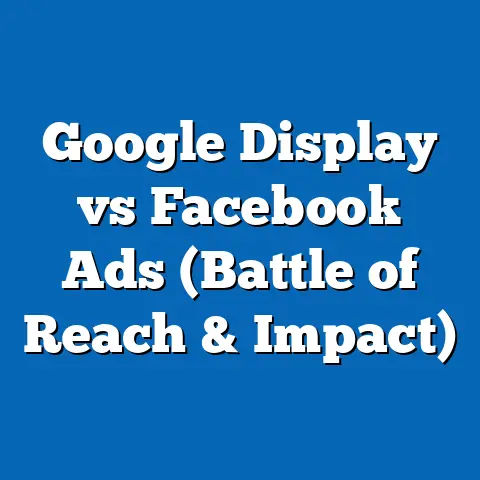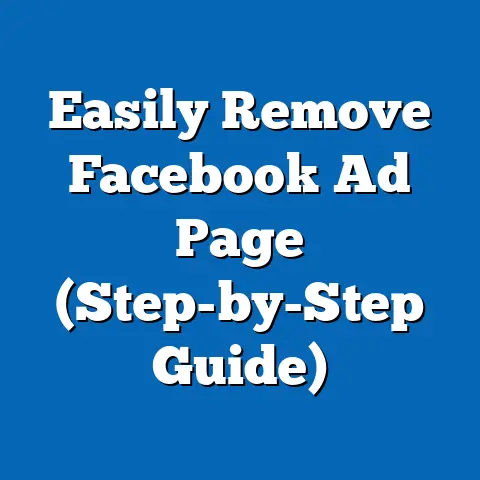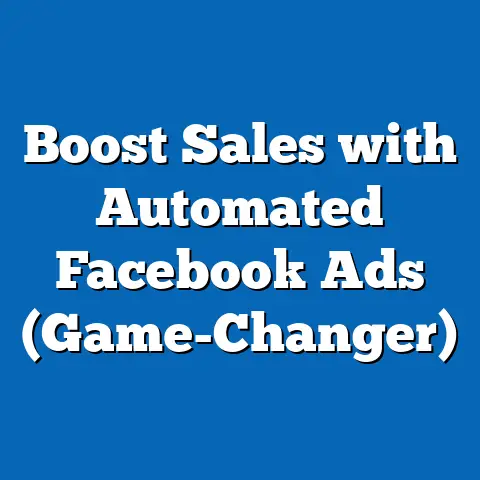Perfecting Carousel fb ad Sizes (Ultimate Guide for Success)
“Marketing is no longer about the stuff you make, but about the stories you tell.” – Seth Godin. I’ve always found this quote particularly relevant to Facebook advertising, especially when it comes to Carousel ads. It’s not just about throwing up a product photo; it’s about crafting a narrative that resonates with your audience and compels them to take action.
Introduction
Facebook advertising has become an indispensable tool in the digital marketer’s arsenal. With billions of active users, it offers unparalleled reach and targeting capabilities. However, with great power comes great responsibility – and a great need for optimization. One of the most engaging and versatile ad formats available on Facebook is the Carousel ad.
Carousel ads allow you to showcase multiple images or videos within a single ad unit, offering a dynamic way to tell your brand’s story, highlight different products, or explain a complex process. But here’s the thing: simply creating a Carousel ad isn’t enough. To truly maximize its impact, you need to nail the visual presentation, and that starts with understanding and perfecting your ad sizes.
Think of it like this: you wouldn’t walk into a job interview wearing a wrinkled suit, would you? Similarly, you can’t expect your Carousel ad to perform if it’s poorly sized, blurry, or awkwardly cropped. In this ultimate guide, I’ll walk you through everything you need to know about perfecting Carousel Facebook ad sizes. From understanding the benefits of this format to avoiding common pitfalls, you’ll gain the knowledge and tools to create visually stunning and highly effective Carousel ads. Get ready to learn the secrets to captivating your audience and driving results with perfectly sized Carousel ads!
Understanding Facebook Carousel Ads
Carousel ads are a powerful format offered by Facebook that allows advertisers to display multiple images or videos within a single ad. Each image or video, referred to as a “card,” can have its own headline, description, link, and call-to-action (CTA). This format is incredibly versatile and can be used to achieve a variety of marketing goals.
From my experience, Carousel ads are particularly effective for:
- Showcasing multiple products: E-commerce businesses can use Carousel ads to display different items from their catalog, each with its own price and link to the product page.
- Telling a story: Brands can use Carousel ads to guide users through a narrative, revealing different aspects of their brand or product with each card.
- Explaining a process: Service-based businesses can use Carousel ads to break down a complex service into simple steps, making it easier for potential customers to understand.
- Highlighting different features: Software companies can use Carousel ads to showcase the various features of their product, each with its own description and call to action.
In fact, a study by Facebook found that Carousel ads can drive up to 10x more traffic to websites compared to static link ads. Additionally, they can help reduce cost per conversion by as much as 72%. These statistics speak volumes about the potential of Carousel ads when used effectively.
Key Takeaway: Carousel ads are a dynamic and engaging ad format that can be used to achieve a variety of marketing goals. Their ability to showcase multiple images or videos within a single ad unit makes them a powerful tool for storytelling, product promotion, and lead generation.
Importance of Ad Sizes
Why does ad size matter so much? It’s a question I get asked a lot, and the answer is multifaceted. The size and dimensions of your Facebook Carousel ads directly impact several key factors that influence ad performance.
- Loading Times: Properly sized images and videos load faster, providing a smoother user experience. Nobody likes waiting for an ad to load, and if your ad takes too long, users are likely to scroll past it without even seeing what you have to offer.
- Mobile Optimization: With the majority of Facebook users accessing the platform on their mobile devices, it’s crucial to ensure that your ads are optimized for mobile viewing. Correct ad sizes ensure that your images and videos display properly on smaller screens, without being cropped or distorted.
- User Experience: A well-sized ad looks professional and visually appealing. It demonstrates that you care about the user experience and are willing to invest in high-quality visuals. On the other hand, a poorly sized ad can look amateurish and detract from your brand’s credibility.
- Ad Visibility and Performance: Facebook’s algorithm favors ads that provide a good user experience. By using the recommended ad sizes, you increase the likelihood that your ad will be shown to more users and achieve better results.
The right dimensions can significantly impact ad visibility and performance by ensuring that your ad looks its best on all devices, loads quickly, and provides a seamless user experience. It’s also important to understand the concept of aspect ratios. Aspect ratio refers to the proportional relationship between the width and height of an image or video. Using the correct aspect ratio ensures that your ad displays properly without being stretched, squashed, or cropped. For example, a 1:1 aspect ratio means the image is square, while a 16:9 aspect ratio means the image is widescreen.
Key Takeaway: Ad sizes are crucial for loading times, mobile optimization, user experience, and ad visibility. Understanding aspect ratios is essential for ensuring that your Carousel ads display properly on all devices.
Recommended Sizes for Facebook Carousel Ads
Now, let’s dive into the specifics. What are the recommended sizes for Facebook Carousel ads? Here’s a breakdown of the key specifications:
- Image Dimensions:
- Recommended resolution: 1080 x 1080 pixels
- Minimum resolution: 600 x 600 pixels
- Aspect Ratio: 1:1 (square)
- Video Specifications:
- Recommended resolution: 1080 x 1080 pixels
- Aspect Ratio: 1:1 (square)
- Maximum video size: 4GB
- Maximum video duration: 240 minutes
- Number of Cards: You can include between 2 and 10 cards in a Carousel ad.
- Recommended resolution: 1080 x 1080 pixels
- Minimum resolution: 600 x 600 pixels
- Recommended resolution: 1080 x 1080 pixels
- Aspect Ratio: 1:1 (square)
- Maximum video size: 4GB
- Maximum video duration: 240 minutes
These are the general guidelines, but it’s always a good idea to check Facebook’s Ads Manager for the most up-to-date specifications. I’ve seen these specs change slightly over time, so staying informed is key.
To ensure high-quality images and videos, use professional-grade cameras and editing software. Avoid using low-resolution images or videos, as they will appear blurry and pixelated. Also, pay attention to file sizes. Large files can slow down loading times, so compress your images and videos without sacrificing quality.
Maintaining brand consistency across different carousel cards is essential for building brand recognition and creating a cohesive visual experience. Use consistent colors, fonts, and logos throughout your Carousel ads. This will help users quickly identify your brand and associate it with your products or services.
Key Takeaway: Use the recommended image dimensions and aspect ratios to ensure your Carousel ads look their best. Maintain brand consistency across all cards and optimize file sizes for faster loading times.
Designing Effective Carousel Ads
Creating visually appealing Carousel ads is an art and a science. It requires a combination of creativity, strategic thinking, and attention to detail. Here are some guidelines to help you design Carousel ads that capture attention and drive results:
- Consistent Branding: Use consistent colors, fonts, and logos throughout your Carousel ads to maintain brand recognition. This helps users quickly identify your brand and associate it with your products or services.
- Compelling Headlines and Descriptions: Each card in your Carousel ad should have a compelling headline and description that clearly communicates the value proposition. Use concise and persuasive language to capture the user’s attention and entice them to learn more.
- Strong Calls to Action (CTAs): Include strong CTAs on each card to prompt user engagement. Use action-oriented language, such as “Shop Now,” “Learn More,” or “Get Started,” to encourage users to take the desired action.
- Storytelling: Use your Carousel ads to tell a story about your brand or product. Each card should build upon the previous one, creating a narrative that engages the user and keeps them interested.
Storytelling is a particularly powerful technique for Carousel ads. Think of each card as a chapter in a story. Start with a captivating hook, introduce the main characters (your products or services), build suspense, and end with a satisfying resolution (a purchase or conversion).
For example, if you’re selling travel packages, you could use the first card to showcase a stunning destination, the second card to highlight the benefits of your package, the third card to feature customer testimonials, and the final card to offer a special discount or promotion.
Key Takeaway: Design visually appealing Carousel ads with consistent branding, compelling headlines and descriptions, strong CTAs, and a captivating story.
A/B Testing Carousel Ads
A/B testing, also known as split testing, is a crucial part of optimizing your Carousel ads. It involves creating two or more versions of your ad with slight variations and then testing them against each other to see which one performs better. This allows you to identify the elements that resonate most with your target audience and fine-tune your ads for maximum impact.
Here’s how to A/B test your Carousel ads:
- Identify the elements you want to test: This could include different ad sizes, images, headlines, descriptions, CTAs, or targeting options.
- Create variations of your ad: Create two or more versions of your ad, each with a different variation of the element you’re testing.
- Run your ads and track the results: Use Facebook’s Ads Manager to run your ads and track key metrics, such as click-through rates (CTR), engagement rates, and conversion rates.
- Analyze the data and identify the winner: After a sufficient amount of time, analyze the data to determine which version of your ad performed better.
- Implement the winning variation: Implement the winning variation in your ad campaigns and continue testing other elements to further optimize your results.
For example, you could test two different sizes for your Carousel ads to see which one generates more clicks. You could also test different images to see which ones resonate most with your target audience. Or you could test different headlines and descriptions to see which ones drive more conversions.
Key Takeaway: A/B testing is crucial for optimizing your Carousel ads. Test different sizes, images, headlines, descriptions, and CTAs to identify the elements that resonate most with your target audience.
Common Mistakes to Avoid
Creating effective Carousel ads isn’t always easy. There are several common mistakes that marketers make that can hinder their ad performance. Here are some pitfalls to watch out for:
- Using Improper Sizes or Formats: As we’ve discussed, using the wrong sizes or formats can lead to blurry, distorted, or cropped images and videos. Always use the recommended specifications to ensure your ads look their best.
- Overcrowding Slides with Text or Images: Avoid cluttering your Carousel cards with too much text or too many images. Keep each card clean, simple, and focused on a single message.
- Lack of Clear CTAs or Messaging: Make sure each card has a clear CTA and a concise message that tells users what you want them to do. Vague or confusing messaging can lead to missed opportunities.
- Ignoring Mobile Optimization: Remember that most Facebook users access the platform on their mobile devices. Make sure your Carousel ads are optimized for mobile viewing by using responsive designs and avoiding small, hard-to-read text.
- Neglecting A/B Testing: As we’ve discussed, A/B testing is essential for optimizing your Carousel ads. Don’t assume you know what works best. Test different variations to see what resonates most with your target audience.
If you’re making these mistakes, don’t worry. The good news is that they’re easily correctable. Simply follow the best practices outlined in this guide and continuously test and optimize your ad campaigns for success.
Key Takeaway: Avoid common pitfalls such as using improper sizes, overcrowding slides, lacking clear CTAs, ignoring mobile optimization, and neglecting A/B testing.
Conclusion
In this ultimate guide, I’ve covered everything you need to know about perfecting Carousel Facebook ad sizes. From understanding the benefits of this format to avoiding common pitfalls, you now have the knowledge and tools to create visually stunning and highly effective Carousel ads.
Remember, the key to success with Carousel ads is to:
- Use the recommended image dimensions and aspect ratios.
- Maintain brand consistency across all cards.
- Design visually appealing ads with compelling headlines and descriptions.
- Include strong CTAs on each card.
- Tell a story that engages the user and keeps them interested.
- A/B test different elements to identify what resonates most with your target audience.
- Avoid common pitfalls such as using improper sizes, overcrowding slides, and neglecting mobile optimization.
By following these best practices, you can maximize the effectiveness of your Facebook advertising and drive results for your business.
I encourage you to implement the best practices outlined in this guide and to continuously test and optimize your ad campaigns for success. Facebook advertising is a dynamic and ever-evolving landscape, so it’s important to stay informed and adapt your strategies accordingly.
Call to Action:
Now I would love to hear from you! Share your experiences with Carousel ads in the comments below. What strategies have worked best for you? What challenges have you faced? And if you’re looking for more personalized advice on Facebook advertising strategies, don’t hesitate to reach out. I’m always happy to help!

